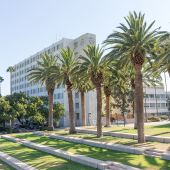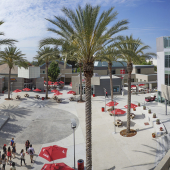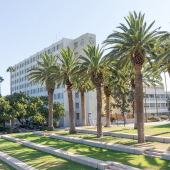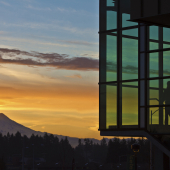Anyone who has been to the United States will tell you that one of the first things they were struck by was the sheer size of the place. The roads are wide, the shops are vast and if you find yourself in a national park or on the middle of a highway, the sheer enormousness if the country really dawns on you.
There is also so much variance in the climate, the style and the types of people you will find in the different areas of the USA that you would be remiss not to give some serious consideration to the area you will be studying in.
Northeast
New England – Connecticut, Maine, Massachusetts, New Hampshire, Rhode Island, Vermont
Mid-Atlantic – New Jersey, New York, Pennsylvania
New England is so named as it was the where the English Pilgrims first settled in America. It is therefore a place of great tradition, including being the birthplace of the American War of Independence.
This also means some of America’s oldest and best known universities are here, including Harvard, MIT, Yale, Dartmouth and Brown.
Some of New England’s biggest cities include Boston (Massachusetts), Worcester (Massachusetts) and Providence (Rhode Island).
Though geographically small, there is a broad variety of natural features in the area, with coastal regions, beaches, rolling hills and the Appalachian Mountains. New England gets warm summers and long, snowy winters.
The Mid-Atlantic was settled by the Dutch, the Swedes, and both English Catholics and Quakers. This ethnic and religious diversity has continued through to the present day and helped define the United States as a land of opportunity for all.
The Mid-Atlantic’s biggest cities include New York City (New York), Philadelphia (Pennsylvania) and Newark (New Jersey). With popular universities like Columbia, Cornell, Princeton and the University of Pennsylvania, the Mid-Atlantic, as with virtually all of the USA’s regions, is home to exceptional education choices.
Midwest
East North Central - Illinois, Indiana, Michigan, Ohio, Wisconsin
West North Central - Iowa, Kansas, Minnesota, Missouri, Nebraska, North Dakota, South Dakota
The Midwest is typically divided into the East North Central States, which border the Great Lakes, and the West North Central States, which are mostly located within the Great Plains region.
The Midwest is often described as ‘the heartland’ of America, partly due to the heavy industry and agricultural roots of the region, with the East North Central area being the more industrious and West North Central the more agricultural.
The Midwest is mostly flat, making is ideal for the farming mostly executed in the West North Central area. The Midwest has cold winters but hot summers and it gets rainier the further west you go.
Those states around the Great Lakes tend to have the larger and more populous cities, such as Chicago (Illinois), Indianapolis (Indiana), Columbus (Ohio), Detroit (Michigan) and Milwaukee (Wisconsin). Therefore, there are more easily recognisable universities in this region, such as the University of Chicago, Northwestern and Notre Dame, alongside a high number of smaller, highly respected colleges.
South
South Atlantic – Delaware, Florida, Georgia, Maryland, North Carolina, South Carolina, Virginia, District of Columbia, West Virginia
South Central – Alabama, Kentucky, Mississippi, Tennessee, Arkansas, Louisiana, Oklahoma, Texas
The Southern United States, much like the Midwest, can be divided any number of ways, but for ease, here we will collect them into the South Atlantic states and South Central States.
Historically, the living experience in American North and the American South were virtual opposites, but in recent years they have converged and are mostly fairly similar. There are still differences, however, the South has its own unique cultures, music and food. If you enjoy barbeque or soul food, country music or rap, the South has been incredibly influential culturally across the entirety of the US.
One other big difference is the climate- the South gets far warmer than the North. It differs a little per state of course, and gets a little cooler in the South Atlantic states, but everywhere you can expect mild winters and very hot summers.
Some of the better known cities in the region are New Orleans (Louisiana), Memphis (Tennessee), Miami (Florida) and Dallas (Texas). Whereas the universities in the Northeast are mostly private, the South have a strong state university presence. Some of the best include the University of Alabama, University of Tennessee, Texas A&M, University of Oklahoma, North Carolina State University, University of Florida, University of Virginia, University of Delaware and the University of Kentucky.
West
Mountain – Arizona, Colorado, Idaho, Montana, Nevada, New Mexico, Utah, Wyoming
Pacific – Alaska, California, Hawaii, Oregon, Washington
The Western United States are divided in two by the Rocky Mountain range, with those on the coastal Western side being the Pacific states and those to the east of the Rockies being the Mountain States.
As with all of these broad categorizations of the United States, how can we boil so much into just a few words? Some parts of the West are true desert (parts of Nevada and Arizona, for example) while some get lots of rain and snow (parts of Oregon and Washington). There is an enormous amount of unfarmed open, public land but also enormous metropolises.
The Mountain States are fairly hilly, believe it or not, with popular destinations like Phoenix (Arizona), Denver (Colorado), Las Vegas (Nevada) and Salt Lake City (Utah).
Generally though, students are attracted to the beaches and glamour of the Pacific States, especially California, which contains many renowned universities, particularly under the University of California umbrella. Berkeley, Los Angeles, San Diego, San Francisco, Santa Cruz and more are part of the UC system, with thousands of students attending every year. If you are thinking of studying in the West, the University of California would be a good place to first begin your considerations.










